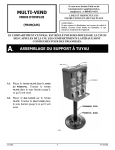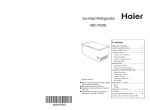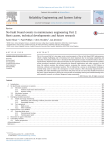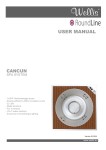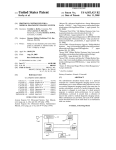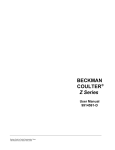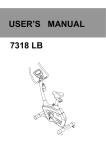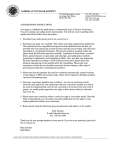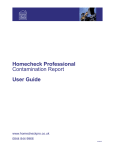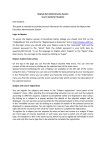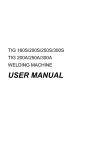Download User Manual - Chemgeneration
Transcript
ETITION SCIENCE COMP for high-school stud ents Chain Reaction Science Competition User Manual Physics & Chemistry Experiments Introduction Dear Student, If you’re reading this manual, it probably means two things: you are interested in science, or you like to have fun with your schoolmates. Well, the Chain Reaction Science Competition will show you that these two things can be connected pretty well. Below, there is a brief summary for you explaining what the Chain Reaction Science Competition is exactly, and what you need to do to become a part of this fun, which also helps you improving your knowledge. Are you ready? Let’s get started, be creative and smart! User Manual Chain Reaction Science Competition What is a Chain Reaction Machine? The Chain Reaction machine is a special structure built from everyday materials, in which physical and chemical reactions follow each other. Each reaction triggers another action, which make the whole machine work continuously. For example a rolling ball pushes a domino line, which overturns a cup of salt which falls into a container filled with water, and since the salt water conducts electricity, it lights a LED, etc., etc. History History of the contraptions dates back around 100 years, when an American cartoonist and inventor, Rube Goldberg, built the first machine that performs a very simple task in a very complex way, usually including a chain reaction. Maybe, the most famous one of these “inventions” was the Self-Operating Napkin, through which the world met these spectacular contraptions. Everyone loves funny machines In USA, there are still plenty of school projects, competitions and leisure clubs built around this theme, and students are also eager to construct Rube Goldberg Machines. The NASA and the Google have also organized similar competitions, and there is a brand new TV series has launched on the Discovery Channel about this kind of machines. Aim of the Chain Reaction Science Competition The key objective of the Chain Reaction Science Competition is to draw attention to the importance of science, and to the fact that physics and chemistry can be very funny and interesting, and they are not only a few formulas to be mugged up. Physics and chemistry move the world around us. Now it’s your turn to make them move! Physics and chemistry surround us invisibly. If you take part in the competition, your task will be to observe, analyze, and scientifically “copy” these processes and reactions. How? Be creative as much as you can! In the meantime, you can see for what empty water bottles, cola cans and nylon bags or actually any kind of recyclable wastes are good, thus you can also keep an eye on the environment and sustainability. Who can enter the competition? Teams of high school students (aged between 14 and 18) can take part in the Chain Reaction competition. Each team consists of maximum five students and one supervisor (chemistry teacher). Members of the team will be chosen by the chemistry teacher according to the performance of students in the planning period, namely the ones who bring the best and the most original ideas which can be scientifically justified. What is the task? The task is to plan and then build a Chain Reaction machine, which is a series of spectacular chemical and physical reactions. The team can use various materials for the construction: • Various tools and materials in the Magic Box*, • Accessories and materials found in the school’s chemistry lab • Any other items, even toys brought from home (e.g. empty PET bottles, homemade things for example from cardboard, plastic toys, etc.) * The Magic Box is a free starter kit containing a variety of tools and materials, which are available for schools in a limited number. The Magic Box is not subject to participation in the competition. 3 User Manual Chain Reaction Science Competition How to do it? Transform everyday materials into an extraordinary contraption! 1. Plan it! Think about physical and chemical reactions that you would build in the Chain Reaction machine. You can use this manual and the videos showing some experiments on the CHEMGENERATION.COM website. Gather your ideas, draw and write them down, and when you’re done, show it to your supervisor chemistry teacher. 2. Try it! The most promising ideas as well as physical and chemical reactions wished to be used should be tested in practice, but of course only under the supervision of your chemistry teacher, before the construction of the machine starts. The more you test a reaction, the more reliable it will operate in the Chain Reaction machine. Don’t try chemical experiments at home. Read the “Safety instructions” section on page 6! 3. Build it! If you have really good ideas, you can be one of the five members of the team entering the competition. Here comes the real teamwork: you and the other members of the team need to build the Chain Reaction machine step-by-step, using all of your ideas. Take the time for the task: you need to be busy with the machine, which you have to build in one of the school’s room, in breaks and sometimes after school as well. 4. Make a video If the machine is ready, you have to present it while operating on a video. This might seem an easy task, yet complex: the short video has to be one “shot” meaning that the camera always has to film what is actually happening. After one of the team members demonstrate the machine under operation step-by-step, she/he can present his/her theoretical knowledge as well. For explaining the chemical and physical reactions of the chain reaction process, you can use a flipchart or a board. The film can be as long as you want, but try to make it interesting and busy during the whole time. 5. Upload the video In the end, the application form needs to be submitted online along with the video file which has to be uploaded via the CHEMGENERATION.COM website. Application has to be submitted by the supervisor teacher. 6. Tell your friends and acquaintances to vote! From now on, you can be excited. Until the professional jury judges the received videos, the public can vote on submitted videos on the CHEMGENERATION.COM website. Go for audience votes! Tell your friends to watch the video and vote for it, if they like it. First, your supervisor teacher will get the results of the competition, and then he/she will tell you the hopefully good news… Details and registration: http://www.chemgeneration.com/chainreaction/ 4 Basic Rules The automatic machine The essence of the Chain Reaction machine is that, after giving it a start, it has to work on its own using physical and chemical reactions without human assistance. Minimum 10 steps The machine has to contain at least ten steps. Of course, it can be more: the longer and more interesting it is, the better result the team can achieve. Minimum 3 steps based on a chemical reaction The machine should contain at least 3 steps, which are based on chemical reactions (e.g. electrolysis, volumetric expansion of substances, salt + acid reactions, solubility of solids, etc.) Check chemistry experiments in this manual carefully and gather ideas with your chemistry teacher, then think it over which reactions can be built in the Chain Reaction! One touch allowed As we described in Section 1, the aim of the Chain Reaction machine is that after giving it a start, it has to work on its own using different physical and chemical experiments without any further human assistance. It may happen that something goes wrong with the machine and it gets stuck. In this case, it is allowed for one of the team members to help it and intervene once, but only once. One cut allowed Basically, the video presenting the Chain Reaction has to be one “shot” meaning that the camera always has to film what is actually happening. Only in the case of chemical reactions, however, it is possible to cut it once, which can be made with a video editor program afterwards. This solution is only accepted, if one chemical reaction requires such a long time that the camera should wait for many minutes until the reaction is finished. Visual Elements Not all chemical reactions are suitable for carrying on the Chain Reaction. For this reason, it is allowed to use chemical experiments as visual elements. In this case, the reaction does not start the next movement, only takes place by itself, as a visual element. You can keep the Chain Reaction going on by initiating two processes with one movement at the same time: one of them is the chemical reaction taking place on its own, while the other one triggers the next movement of the machine. Sustainability Since sustainability becomes more and more important, the jury gives extra points for machines that uses green energy (e.g. solar, wind and water power, etc.), recycling (e.g. recycled paper), or a variety of environmentally friendly materials and high-tech solutions (e.g. biodegradable plastics, LED, etc). Earn extra points You can help popularizing science by displaying the CHEMGENERATION.COM logo in the machine in different ways (e.g. on paper flags, with stickers, etc). These visuals elements mean plus points for your team, which are given by the jury. The CHEMGENERATION.COM logo can be downloaded from the following URL: http://www.chemgeneration.com/logo.zip Make others laugh! Although physics and chemistry are major sciences, we do absolutely not mind if you present natural sciences in a funny way in your application, since one of our main slogans is: Chemistry is cool, science is fun. The funnier your video is, the more successful it will be, because more people will vote for it. Important: Detailed rules and regulations of Chain Reaction Science Competition can be found in the Competition Rules and Regulations document on the CHEMGENERATION.COM website. http://www.chemgeneration.com/chainreaction/competition_rules_and_regulations/ 5 User Manual Chain Reaction Science Competition We help you We don’t leave you alone during the planning and the working period either. We support your preparation and practical work with the following materials: Chain Reaction User Manual The Chain Reaction User Manual, which you are reading right now, is an official helping material of the Chain Reaction Science Competition. It contains short, illustrated descriptions of physical and chemical experiments, which your team can use in the Chain Reaction machine. Read and improve them, plan how they can be connected to each other, and find out new reactions as well. Experiment videos on CHEMGENERATION.COM Videos of the experiments described in this manual can be watched on the CHEMGENERATION.COM website. Physical and chemical experiments are clearly shown step by step in slow motion as well so that you can observe every detail. The videos can also give ideas about how to connect certain experiments to each other. The User Manual can be downloaded as a printable electronic document in .PDF file format from the following page: http://www.chemgeneration.com/chainreaction/usermanual/ Educational videos can be watched on the following page: http://www.chemgeneration.com/chainreaction/videos/ Prizes First prize All the members (5 students) as well as the supervisor chemistry teacher of the best team chosen by a professional jury will get valuable prizes as well as the school of the winner team, who will get educational materials. Audience award All Chain Reaction videos will be uploaded to a video gallery on the CHEMGENERATION. COM website, and the public can vote for them. The video having the most votes will win the ‘public award’. Prizes and details of the announcement of results can be found on the CHEMGENERATION.COM website: http://www.chemgeneration.com/chainreaction/ Safety instructions Careful use of equipments All physical and chemical experiments require attention and caution. All equipments and tools have to be used in the proper way. Don’t give tools of the Magic Box to young children, only you and the members of your team are allowed to use them. Always work accurately, in a clean environment. Chemistry Experiments: only under the supervision of a teacher During the implementation of chemistry experiments described in this manual, you can get in contact with various chemicals, some of which are hazardous to health or the environment. For this reason, all experiments have to be carried out according to chemical safety legislation. It is important to know that experiments indicated with red warnings in this manual can be carried out with proper precautions only under the strict supervision of a teacher. Don’t try chemical experiments at home! 6 Appendix Physics and Chemistry Experiments The sample experiments described in the following pages may be helpful in the construction of Chain Reaction machine. Immerse out ideas and develop them further! Attention! The physics and chemistry experiments can be watched on videos at the Chemgeneration.com website: http://www.chemgeneration.com/chainreaction/videos/ Warning! Some chemical reactions need chemicals which are dangerous to health or the environment. We recommend trying these experiments in the school’s chemistry lab under the supervision of the chemistry teacher. Don’t try chemical experiments at home! Read the “Safety instructions” section on page 6! Experiments Chain Reaction Science Competition Collision Collision is a brief dynamic event consisting of the close approach of two or more moving bodies, resulting in an abrupt change of velocity (momentum, impulse). Since in the Chain Reaction, you need to keep objects in constant motion, it is inevitable to use collision. There are many types of collision. One of them is the perfectly elastic collision, which is an encounter between two bodies in which the total kinetic energy of the two bodies after the encounter is equal to their total kinetic energy before the encounter. Let’s see some examples how you can apply them in the Chain Reaction! Newton’s Cradle Create a Newton’s Cradle, which uses perfectly elastic collision, in which the last ball starts the next element of Chain Reaction! Put balls hanging on ropes closely together. When you push one of the outer balls the following process occurs: If two bullets having the same weight collide, the collision speed is interchanged. If one of the ball moves and the other one is stopped, then the moving ball stops and the stopped one starts to move with the previously moving ball’s velocity. If the balls are in line, the force travels through the line and pushes the last ball upward. Then, the same thing happens to the other direction. If more balls are lifted on one end, then the same amount of balls will be lifted on the other end of the series of the spheres. Collision on a rail If you want to slow down a body as much as possible or even stop it through collision, use the perfectly inelastic collision. Set two rolling objects having equal weights face to face on a rail, and then toss them to each other with the same force. In this experiment, the momenta of the two bodies having opposite directions quench, the kinetic energy is lost, so the two bodies stop. Tip: To exactly know what happens when bodies collide, check the conservation law of energy and the conservation law of momentum (impulse) too. Uniformly varying motion: Acceleration Acceleration is the rate at which the velocity of a body changes with time. This can be positive or negative (deceleration). Let’s see how to use these movements in the Chain Reaction! Inclined plane Build an inclined plane from a wooden shelf by putting some books under one of the shelf’s ends. Let an object (e.g. a marble or a steel ball) go at the top of the slope. You will see that the body will roll down using the uniformly accelerated motion. Sand on the inclined plane Now put sand on the lower side of the shelf and roll down the marble. You will see that due to the rolling resistance the body will move with a decelerating motion (negative acceleration) where the sand is put. If the friction level is high enough or the slope is long enough, the ball may even stop. Tip: Try different materials. Note which material is the best for reaching the lowest possible friction and for acceleration or deceleration of objects. 8 Physics Free fall, gravity If you let an object fall in the gravitational field of Earth, it will move towards the center of Earth. Free fall occurs when this movement is not blocked. It is also interesting to note that every object has the same gravitational acceleration. That is why, if two objects having the same size but made from different materials are dropped from the same height, they will land at the same time. Let’s see an example! Fall Build two upright tubes from plastic bottles, then drop a light foam ball in one of them, and a heavy iron ball in the other one at the same time. You’ll see that both will reach the ground at the same time. Think about how you could use this phenomenon in the Chain Reaction. Tip: To know exactly what happens in free fall, look up the law of universal gravitation. Drag Drag refers to aerodynamic or hydrodynamic forces, which act opposite to the direction of the movement of a solid object. Drag force is equal to the force of the solid object, which moves at constant velocity. For example drag depends on the quality of the medium, or the size, shape and speed of the body as well. If you want an object to move slow in the Chain Reaction use drag forces. Let’s see some examples. Hydrodynamic drag cocktail Create layers of fluids having different density in a measuring tube (e.g., edible gelatin, honey, water, oil, etc) and put the densest at the bottom of the tube. The experiment will be even more spectacular if you use food colorings to color the different layers. Drop an object into the tube, and you will see that the object will go through less dense upper layers faster than lower denser media, where it slows down or stops. Parachute Air also acts on moving objects, which is called air resistance. To experience this build a parachute from everyday materials. Cut a circle from a plastic bag and fix cords at its edge, one cord per a few centimeters. Fix ballast on it and the parachute is ready. Test parachutes of various shapes and sizes to find out which one is the most affected by drag. How would you fix your parachute so that it only goes down if the previous element of the Chain Reaction makes it move? 9 Experiments Chain Reaction Science Competition Spiral and circular movement Circular movement occurs when an object moves along a circular path. Circular and spiral movements can be achieved through the centripetal force, which makes a body follow a curved path. This may result from gravity (orbs), electrical attraction, compressive force or cable force. The spiral and circular movement can be impressive in the Chain Reaction. Here are some examples. Paper cone Make a cone-shaped paper bag, set it upright, get a marble spinning rapidly in a circular path and you can already see the spiral movement. Forces (gravity and compressive forces) make the marble travels along a circular path and downwards as well. How can you add this to the Chain Reaction? Simply cut a hole at the bottom of the cone-shaped paper bag so that the ball comes out of the cone and pushes the next element of the Chain Reaction. Glass rolling around Put a cone-shaped glass or an Erlenmeyer flask to the side and toss it. Due to the shape of the glass, it will move along a circular path. Spiral slide Build a spiral path from wires or transparent plastic tubes, and study the forces acting on the ball rolling down. Look how the ball moves in the curves. Pendulum A pendulum is a weight suspended from a pivot so that it can swing freely, if it is displaced sideways from its neutral equilibrium position. A pendulum swings with a specific period. The pendulum movement can be observed in a number of everyday structures, such as the pendulum clock, the swing and the skittles. The pendulum movement can also be used in the Chain Reaction. Let’s see how to do that. Hammer pendulum Fix a hammer handle to a point, lift the head of the hammer high and fix it. When the previous element of the Chain Reaction untie the fixing of the hammer’s head, it starts to swing and it can push another object. Table skittles Attach ballast (e.g. heavy ball) to the end of a rope, fix the other end of the rope, lift the ballast to one side and fix it. If you loose the fixing, the object starts to swing. If you put object in the way of the swinging object, the pendulum tosses them, which make the Chain Reaction go on. Tip: Find out how the pendulum clock works. 10 Physics Simple machine: pulley A simple machine is a mechanical device that changes the direction and/or magnitude of a force. In other words, one of their most important characteristics is that by using them, you need to exert less or more concentrated force to move objects. Of course, the required energy is the same. A fixed pulley, which has an axle mounted in bearings attached to a supporting structure, is one of these useful machines. Let’s see how you can use it in the Chain Reaction! Simple pulley Put a rope over a fixed pulley and attach a heavy object at one of the rope’s ends. You can easily lift up the object with the pulley, if you pull down the other end of the rope. Tip: Since you can’t move the objects with your hand in the Chain Reaction, it can be a good solution if you put a counterweight on the other end of the rope, and you use the gravitational force to make the object move. Archimedes pulley system Build an Archimedes pulley system, which contains many pulleys. In this structure, each pulley halves the load, so you can easily lift up a heavy object. For example the crane used on construction sites works like this. Domino effect Falling of dominoes set up in a row is caused by a shock wave, which goes through the whole system. The speed of the falling depends on the height of the dominoes, the distance between them and the gravity. Experiments show that the falling of the domino row is the fastest, if the distance between dominoes are two third of their height. The falling row of dominoes can be impressive and successful in the Chain Reaction. Falling row of dominoes Set up stable objects, which can fall easily (e.g. matches), parallel, at the same distance. If you push the first object, the shock wave goes through the whole system and all of them will fall. Well, but what is happening? Due to the shock wave, objects are displaced from their equilibrium position and they fall due to gravity. Growing row of dominoes Put bigger and bigger objects in a row, and see that an object can overturn another object, which is one and a half bigger than the previous one. This can be really impressive in a Chain Reaction! Now, you just only have to figure out the next element of the Chain Reaction, which will be launched by the domino row… Launch In order to throw an object up high, you have to give the initial momentum (or energy). The magnitude of this force has to be enough to overcome gravity force. For example, this force can be observed as a spring force in a stretched rubber band (see in section 10) or as a reaction force when a rocket is launched. The launch can be an interesting part of the Chain Reaction. Let’s see some examples. 11 Experiments Chain Reaction Science Competition Spatula catapult Make a catapult using a spatula and rubber bands. In this case, the force necessary to launch the catapult is given by the elastic force of the rubber band. You can launch anything without touching the machine, thus this can be an impressive part of the Chain Reaction: fix the cocked catapult with a cord, and then release it by burning the cord. Effervescent rocket Use overpressure force caused in a chemical way by gasification: throw effervescent into a bottle half filled with water, and then close it with a cap. Gas starts to evolve, which soon throws the cap up high. Such a blasting reaction can easily start the next element of Chain Reaction. Tip: Using a long-necked bottle, you manage to control the time so that the effervescent falls into the liquid only when the previous element of the Chain reaction makes the bottle move. Spring force If you elongate or compress a spring, there is force applied. This force is directly proportional to the change in length, which means that the more the spring is elongated, the bigger the force is applied in it. Rubber behaves the same way. The spring force is very useful in the Chain Reaction, if you want an object to move very fast. Here are some examples. Spring elongation Hang a spring on a hook, and fix a heavy object on the bottom of it to elongate the spring. As you hang heavier and heavier objects on the spring, it elongates more and more and you can observe the bouncing movement. Rubber engine Make a rubber engine for a vehicle with propeller, for example for a small boat or a plane: Fix the end of a rubber band to the rotary axis of the vehicle’s propeller with a hook, then knot the other end to a fixed point at the end of the vehicle. If you rotate the propeller the rubber band rolls up and becomes tenser and tenser. The rubber will store the elastic energy until the propeller is fixed. When you release the propeller, the rubber band unrolls, makes the propeller turn, and the vehicle starts moving... Pullback toy car You can use a spring-powered ‘pullback’ toy car in the Chain Reaction! How does this centuries-old invention work? The backward-moving wheels make a spiral spring tense in the car. If you let the car go, the stored energy in the spring is suddenly transmitted to the wheels and the car starts. Tip: Ask your chemistry teacher, what molecules and bonding forces are responsible for the rubber’s elasticity. 12 Physics Buoyancy Buoyancy is an upward force exerted by a fluid or gas that opposes the weight of an immersed object. Any object in a fluid or gas, is buoyed up by a force equal to the weight of the fluid displaced by the object. This is Archimedes’ principle. In the Chain Reaction, you can use buoyancy to move objects in fluid. Let’s see some examples. Diving balloon Fix a medium inflated balloon at the bottom of a dish or an aquarium filled with water. If you untie the rope, buoyancy forces the balloon to the surface. Of course, the rope fixed to the balloon can carry a smaller object, which can continue the Chain Reaction. Sugar Cube ballast You can study the buoyancy by using polystyrene foam ball too. Since this material encloses a lot of air, it will be difficult to sink. You have to fix a lot of ballast, for example sugar cubes on it to sink it. Note that the weight of sugar cubes have to be larger than the buoyancy of the two bodies (the sugar and the ball). After sugar cubes dissolve in water, buoyancy forces the ball to the surface, which can hit another object, and the Chain Reaction can go on. Thermal expansion Thermal expansion is the tendency of matter to change in volume in response to a change in temperature. The thermal expansion can be observed in the everyday life too, for example in the case of metals, but the Stirling engine, a heat engine also works according to this principle, which you can use in the Chain Reaction very well. Let’s see how. Stirling engine Build a Stirling engine from everyday objects. The machine is able to make a rotary axis move due to heated air, and this can induce another movement in the Chain Reaction. Propeller rotating on heat The air density decreases upon heating. A lightbulb or a tea light may heat up the air so much that the rising air makes a small windmill move. Tip: Look up the laws of thermodynamics. 13 Experiments Chain Reaction Science Competition Changes of state of matter Matters have different physical properties depending on the state of matter. Solids can be transformed into liquids by melting; liquids can be transformed into gas by evaporating. You can use the changes of state of matter in the Chain Reaction as well. Here are some examples. Fire, ice and water Put a few ice cubes in a metal plate, which you heat with a candle from below. When the ice melts, the water flows away from the surface, and the dripping water can start another action in the Chain Reaction. Small steam engine Make a steam-powered propeller from everyday objects! Pierce through a large cork and put a tube through the hole. Then, cut the lid off from a metal can, fill it with water, and fix the cork tight onto the can. If you boil the water, the vapor (steam) can only go through the small tube, which can make even a propeller move. Weight change The body weight is proportional to its mass. The change of weight often results changes of movements, so you can easily apply it in the Chain Reaction. Here are some examples. Sponge-balance Put one-one sponge on the two sides of a seesaw, make sure that the two sides are perfectly balanced. Then drip water on one of the sponges. You’ll be surprised about the fact that a small piece of sponge is able to absorb plenty of water. The interesting part of the experiment is that the sponge volume doesn’t change, but its weight can be multiplied. Marble slide Put marbles to an empty plastic cup, which is knotted to a fixed pulley with a rope. As the weight of the cup increases, the system starts to move: the cup starts to move downwards, and launches the next element of the Chain Reaction. Electric current from renewable energy sources An electric current is an ordered flow of charged particles (electrons and ions). It can be derived from a variety of sources, such as fossil energy sources, renewable energy sources or even from chemical energy (see: Fruit cell). Use renewable energies for producing electricity or for moving objects in the Chain Reaction. Here are some examples. Mini hydroelectric power plant Connect the axis of a water wheel made from everyday materials to a DC micro motor (low-powered electric motor), which can be used as a generator as well. If water flows onto the wheel, it starts moving and it transfers its energy to the generator, which converts the kinetic energy into electrical energy. This energy is able to flash a LED. The same experiment can be done with wind turbines driven by a fan, since during the exploitation of wind energy the kinetic energy is also converted to electrical energy. 14 Physics Homemade solar panel Connect a solar cell to a DC micro motor (low-powered electric motor) using wires. The solar panel produces electricity in a chemical way, it provides energy to the motor, which can rotate the wheel. Tip: If there is not enough light for the experiment, put a mirror near the window and direct the light onto the solar panel. You can also use a lamp with strong light. Sailboat The wind energy can induce movement of vehicles. The air coming out of a fan or a hairdryer transfers energy to a light object, for example to a toy sailboat floating on water. Now, you only need to figure out how to turn on the fan or the hairdryer in the Chain Reaction! Gear A gear is a rotating machine part having cut teeth, or cogs, which mesh with another toothed part (generally another gear) in order to transmit torque. Geared devices can change the speed, torque, and direction of a power source. For example, gears work in transmissions of bicycles, and they are responsible for the transmission between the drive shaft and the driven wheels. The gear can be easily integrated in the Chain Reaction. Let’s see an example! D.I.Y. (do it yourself) gears Build up a system containing gears of different sizes from everyday objects. Give initial movement to the first gear, and the other gears will also start to move at different speed depending on their size. If you fix a shovel on the last gear, it can push another object, and the Chain Reaction can go on this way. Magnets A magnet has always two poles (North Pole and South Pole); one Pole on its own doesn’t exist. Opposite poles attract, same poles repel each other. Magnets affect not only each other but certain metal objects (iron, ferroalloys): both poles attract them. Metallic objects can be moved easily with a magnet in the Chain Reaction. Here is an example. Magnetic inclined plane Move a heavy steel ball upwards on an inclined plane with a strong magnet so that you move the magnet under the plane. The ball will follow the movement of the magnet until it is in the magnetic field. Think about how you could use this phenomenon in the Chain Reaction! Tip: Find out what the eddy current is, and what materials are currently used as the most powerful magnet. 15 Experiments Chain Reaction Science Competition Vibration All vibration that has any periodic features in time is called vibration. Mechanical vibration is a phenomenon whereby oscillations occur about an equilibrium point. Vibration can trigger an interesting and spectacular movement in the Chain Reaction. Let’s see an example. Woodpecker Observe the traditional toy, called the woodpecker on a pole and try to copy the phenomenon observed. If you let the small bird fixed on a spring system go at the top of the pole, you will see that it does not fall down immediately, but goes down slowly while vibrating. In this complex motion gravity, vibration and friction also play important roles. Tip: Find out what the resonance is, and what happens when pushing a person in a playground swing to make the swing go higher and higher. Equilibrium, center of gravity Equilibrium exists when forces acting on the body or the system balance each other. Objects displaced from their equilibrium state can induce spectacular movements in the Chain Reaction. Here are some examples. Floating Forks Put two forks into each by their teeth, and insert a match between the middle teeth from their concave side. Place the whole thing upside down and on the top of the match. It is almost unbelievable but the forks do not fall down, and they easily stand at this seemingly unstable position. The explanation of this surprising phenomenon is that the center of gravity of the system is right under the supporting point (rotation axis). Balancing tightrope walker Stretch a rope and place a rolling object (e.g. toy motorcycle) on it. Put weights on both sides so that they hang under the level of the rope. Since object’s center of gravity is below the point of support, the object remains in balance and can move along the rope. Supple-jack Cut a ping-pong ball in two halves and fix ballast inside, for example a heavy bolt. Glue back the upper part of the ball to the lower part and put cloth or paper on the whole thing so that the puppet will have a nice body. Since the puppet’s center of gravity is on one side, no matter how you move it, it always returns to its original neutral position. 16 Physics Counterweight A counterweight is a counterbalancing weight that balances or reduces the effect of a load. A classic example of a counterweight machine is the ancient trebuchet used in medieval battles. This machine is able to store and release mechanical energy and works by using the gravity, which you can also use in the Chain Reaction. Let’s see how. Trebuchet Fix a counterweight on one end of the beam. Pull the other end of the beam down and fix it. When the previous element of the Chain Reaction untie the fixing, gravity pulls the counterweight down and the other end of the beam is lifted up high while releasing the projectile. Tip: Find out how the tower crane and elevator works. 17 Experiments Chain Reaction Science Competition Solubility Interaction and constant movement of solute and solvent particles make dissolution possible. Solvent molecules get in contact with solute particles, and due to the interaction between them, cohesive strength is broken up, and a shell of solvent molecules forms around solute particles. Occasionally, the dissolution of solute and solvent (e.g. water) is caused by chemical interactions. In this case, solute particles dissolve in the solvent due to thermal motion and concentration equalization. Dissolution can trigger effective and colorful scenes in the Chain Reaction. Here are some examples: Color-changing fruit tea Put fruit tea bags in hot water. The dissolution starts immediately in the hightemperature fluid:first, fast-dissolve pigments color the water bluish. After some time, the liquid around the tea bags starts to change its color: red color appears. The explanation for this slow release is the presence of organic acids which protonate water molecules, thus pH of the solution becomes acidic. This change is indicated by pigment colors, which behave as indicators. Dissolving the insoluble Pour saturated alcoholic solution of sulfur in a bowl filled with water. Non-polar molecules of sulfur do not dissolve in water, but they do in alcohol. The mixture of the two solvents results reduced solubility of sulfur and colloidal particles are formed: suspension evolves. If you send laser light through the glass bowl, the characteristic texture of the suspension can be seen better. Saturated and supersaturated solutions A solution is said to be saturated if the solvent, under certain circumstances, is no longer capable of dissolving more solute, so the equilibrium solubility is reached. In this case, the concentration of the solute is constant. If we dissolve less solute than it is possible, the solution is unsaturated. Since more solids can be dissolved on higher temperatures, supersaturated solution can be made, if a hot saturated solution is cooled carefully. This is not a stable state, excess of the solute precipitates rapidly for example for a mechanical stress. This chemical phenomenon can be built in the Chain Reaction as well. Let’s see how: Liquid sculpture Make supersaturated sodium acetate saline, and then slowly pour it on a table or in a porcelain bowl. As the liquid reaches the surface it immediately solidifies and forms a higher and higher “salt tower”. Thus, even a small statue can be built from the supersaturated saline. Another interesting feature of the experiment is that if you start heating the crystallized sodium acetate, it dissolves in its own crystallization water. (And this is not melting!) 18 Chemistry Thermochemical reactions Thermochemistry is the study of the energy and heat associated with chemical reactions. If a reaction releases energy and heat, it is called exothermic reaction. The opposite is the endothermic reaction, when energy and heat is absorbed. Thermal decomposition of some materials is quite fascinating and dynamic, so they can be used in the Chain Reaction as well. Let’s see an example. Volcano Warm ammonium dichromate with a burning rod. If it begins to sparkle, you don’t need to warm it any more. Warming results in a self-sustaining exothermic reaction accompanied with intensive sparkling which is a very similar phenomenon to a volcanic eruption. The originally orange-red crystalline substance becomes a dark green, loose, powder-like matter. Tip: Check what formation and reaction heat mean! Conductivity of salts There are materials that conduct electricity well, while others do not. The latter is also referred to as insulators. Good conductors are for example the zinc, the copper and metals in general, while the majority of plastics are insulators. The conduction depends on the material’s chemical structure, so if you change it, you can induce conductivity. The easiest way is adding salt. Let’s see an example: Salt-water switch Put graphite electrodes in a bowl filled with distilled water, and install a lowvoltage power source and a consumer for example a LED. The LED is not on yet, but if you put fine-grained salt into the water, and, if necessary, you mix it with the fluid, due to the solution’s ionic compounds water conducts electricity and the LED lights up. Since salt water acts as a switch in the circuit, you can easily make a device start the next element of the Chain Reaction by closing the circuit. Tip: Find out which material is the best electrical conductor! 19 Experiments Chain Reaction Science Competition Electrochemistry Electrochemistry studies chemical reactions evolving due to electric current and the processes and rules of conversion of chemical energy into electrical energy. The generation of electric current can be very useful in the Chain Reaction. Here are some examples. Fruit cell Make galvanic cell from small pieces of metals and fruits, in which chemical reactions produce electricity. Put two different metals (e.g., Cu and Zn) into a juicy, acidic fruit or vegetable and the installed LED flashes immediately. How is this possible? Since the processes of electron loss and uptake take place at different parts, electron transfer occurs between the two parts. The metals and the surrounding solution (in this case, the fruit juice) behave like electrodes and an electrolyte, of which electrical potentials are differ from each other. The two electrodes connected through the solution form a galvanic cell, the difference between potentials of the two electrodes is the electromotive force. The conversion of chemical energy into electrical energy is the result of oxidative and reductive processes occurring in the electrodes. Tip: Find out what are the three basic elements of an electrochemical system! Silver growing In this experiment, you can use the energy of the electric current during electrolysis to induce metal precipitation. Put a solution containing silver complex (diamino argentate) in the Petri dish. Fix the positive end of the power source (this will be the anode) in the liquid, while use a pin as the cathode, which need to be placed gently on the surface of the liquid so that surface tension keeps it there. After turning on the power source, silver is formed on the cathode, which keeps on “growing” on the surface of the liquid. Warning, dangerous material! The experiment has to be carried out with caution under the strict supervision of the teacher. Proper precautions and the use of protective equipments are recommended. Do not try this at home! Acid-base reactions Acid-base reactions are based upon the idea of protonation of bases through the de-protonation of acids that is, the ability of acids to “donate” hydrogen ions or protons to bases, which “accept” them. pH is the measure of acidity or alkalinity. pH indicator is a chemical detector for protons in acid-base titrations. By using indicators, you can produce spectacular color changes in the Chain Reaction. Let’s see an example! Red cabbage indicator Rasp a red cabbage and soak it in water for approx. a quarter of an hour. The blue solution is perfect for the indication of acids or bases for a couple of days: red means acidic, dark purple means alkalescent (slightly alkaline), while green or yellow color means strongly alkaline environment. In the Chain Reaction, the juice of the red cabbage can be mixed with alkaline sud (solution of soap) or with the solution of acidic acetic acid. As the liquids start mixing, you will see the color changes. Tip: Is water an acid or a base? Or maybe both? Find out what an ampholyte is! 20 Chemistry Hidden writing The hidden writing, which can be developed chemically, requires a reaction, of which the end product is colorful, but at least one of the reactants is colorless. First, we write on the paper with the colorless reactant, then we induce a color reaction while developing. The reaction can be based on acid-base, precipitation, oxidation-reduction or complex redox processes as well. In the Chain Reaction, chemical formulas or funny messages can also be displayed using hidden writings without touching the machine. Let’s see how! Hidden writing with turmeric Dip an ear stick into an alkaline solution, for example to the aqueous solution of baking soda, and then write something with it onto a white filter-paper. The writing is not visible yet, because the baking soda solution is colorless. If you put the solution of turmeric onto the paper, the white paper becomes yellow while the alkaline surface of the writing becomes brown. What is the explanation of this phenomenon? The pigment called curcumin becomes brown in an alkaline medium, so it behaves as an indicator. Tip: In the Chain Reaction, a full glass of turmeric extract can be poured onto the paper with the baking soda writing, thus your secret message will be visible immediately. Colorful metal letters Write something on a paper with a solution of different metal ions (for example, antimony or lead salt). If the paper is exposed to hydrogen sulfide gas, colorful metal sulphides are formed, and the transparent antimony salt becomes reddish-orange, while the lead salt becomes brownish due to the precipitation reaction. Acids Acids are compounds that donate protons to water molecules, and thereby the pH of the aqueous solution becomes acidic, its pH is reduced. Solutions with a pH less than 7 are said to be acidic. Many kind of acids surround us in our everyday lives, for example the acetic acid, which we use in the kitchen, the hydrochloric acid, which we use during cleaning or the Vitamin C, which is actually the ascorbic acid that proved to be effective in protecting our health. The corrosive effects of acids can be very effective elements of the Chain Reaction. Here are some examples. Perforation of aluminum foil Stretch the foil on a surface, and pour at least 20% hydrochloric acid in drops. The aluminum is an amphoteric metal meaning that it is soluble in acids and bases as well, so sooner or later the acid will make a hole in the aluminum foil. How to build this in the Chain Reaction? Place an acid-resistant marble on the surface of the aluminum foil, so that it will only start its way in the machine after the chemical reaction took place and the aluminum foil was pierced. Release fixing with drip method Pour nitric acid in drops onto stretched synthetic yarn. The acid dissolves the thread within a few minutes, so the fixing releases and the Chain Reaction can go on. Warning, dangerous material! The experiment has to be carried out with caution under the strict supervision of the teacher. Proper precautions and the use of protective equipments are recommended. Do not try this at home! 21 Experiments Chain Reaction Science Competition Gas, gas production Gas is one of the states of matter. Gases and fluids behave similarly: they flow and resist deformation. Gases fill the entire volume of their container. Many chemical reactions include formation of gas, which can help to keep the Chain Reaction in motion. Let’s see how. Flying balloon It is well known that a medium inflated balloon with helium rises by itself because helium is less dense than the air around it. This process can be built in the Chain Reaction, for example by fixing ballast to the balloon with a thread which has to be torn somehow so that the balloon rising upwards can hit something. Waving glove Put mixture of baking soda and citric acid into an acid-resistant rubber glove, and then gently pull it onto the mouth of a bottle half filled with water. For the start of the reaction, pour the mixture being in the glove into the liquid. The water-soluble solid substances react with each other, the evolving carbon dioxide inflates the balloon, which can push the next element of the Chain Reaction. Tip: Ask your chemistry teacher, what noble gases are and why are they called like this. Tin-rocket Produce hydrogen from everyday materials. To do this, household hydrochloric acid and two metals having negative standard potential (e.g., zinc-coated and aluminum-coated cans) will be needed. Cut one of the cans into small pieces, put in into a test tube and then pour hydrochloric acid on the top of it. If it starts sparkling, put the other can upside down above the mouth of the test tube. Wait a bit and put the box gently on the table so that the gas stays in the can. Put a burning rod under it... Since the hydrogen evolving from the reaction of acid and metal and the oxygen content of the air in the can form an explosive mixture, the combustion takes place very quickly. The gas expands due to the sudden release of heat, and leaves the can through the opening, and as a consequence the can flies away like a rocket. Warning, dangerous material! The experiment has to be carried out with caution under the strict supervision of the teacher. Proper precautions and the use of protective equipments are recommended. Do not try this at home! Foam production Foam can also be produced with gas production in liquids. If the gas production is quite vigorous, foam producing will be quick and extensive, which can start a motion in the Chain Reaction. Let’s see how. Sparkling volcano Put alkaline baking soda into acidic vinegar, and pour the mixture of water and detergent onto it. The reaction of the acid and the base produces carbon dioxide gas, which make the liquid with the detergent foam in a short time. 22 Chemistry Colorful foaming The hydrogen peroxide decomposes into oxygen and water. This process is very slow but can be accelerated by using the appropriate catalyst: add detergent to concentrated hydrogen peroxide solution, then put potassium iodide on the top of it (instead of the solid material, you can also use saturated solution). Since the iodide ion catalyzes the process, the suddenly evolved oxygen blows the foam. The experiment can be even more impressive if the fluid contains food coloring. Gypsum Foam Warning, dangerous material! The experiment has to be carried out with You can make long lasting foam as well. caution under the strict supervision of the teacher. Proper precautions and the use of protective equipments are recommended. Do not try this at home! You will need aluminum grits, gypsum and sodium hydroxide powder. Pour water on the three materials and mix them well. The aluminum and sodium hydroxide react and hydrogen evolves, which blows the foam. The gypsum hardens quickly, so the foam will last for a longer time. Halogens The term halogen means salt-forming, since these elements form salts with metals. This group includes fluorine (F), chlorine (Cl), bromine (Br) and iodine (I). Halogens are highly reactive, thus they can be found in nature as parts of compounds or in ionic forms. The reactions of halogens and metals make the Chain Reaction impressive. Let’s look at an example! Purple smoke Mix aluminum and iodine powder in 1:1 ratio, then put the mixture on a heat resistant, completely dry surface! Form a small heap from the powder, make a small hole in the middle of it and put one drop of water into it. Since the iodine is a halogen, i.e. salt-forming, it reacts with the aluminum easily. The sudden exothermic reaction takes place on the surface of the water drop, and it becomes faster and faster due to the released heat. The process is accompanied by heat release, light and purple smoke. Tip: Ask your chemistry teacher, why halogens are used in bulbs. Warning, dangerous material! The experiment has to be carried out with caution under the strict supervision of the teacher. Proper precautions and the use of protective equipments are recommended. Do not try this at home! 23 Experiments Chain Reaction Science Competition Combustion Combustion occurs when a substance combines with oxygen in the air. The three conditions required for combustion are: combustible material, oxygen, and ignition temperature. Combustion is always accompanied with light and heat. In the combustion process, it is often the color of the flame that informs us about the material that is burning. Combustion can be impressive in the Chain Reaction, but it can also indicate movement. Let’s see how. Warning, flammable material! The experiment has to be carried out with caution under the strict supervision of the teacher. Proper precautions and the use of protective equipments are recommended. Do not try this at home! Flash point Place two beakers on a simple twin-pan balance and pour petroleum in one of them, and gasoline in the other one. Balance it, so that both beakers have the same weight. After that, place a strip of paper between the two beakers, then light the paper in the middle. It is important to know that vapors of volatile liquids can burst into flames without igniting the liquid itself. In this experiment, vapors of the more volatile gasoline will ignite. Because of the weight loss during combustion, the balance is tilted. This movement can start the next element of the Chain Reaction. Wildfire Write a text or draw something on a piece of paper with a brush that was previously dipped into concentrated potassium nitrate solution! Mark the starting point of the text or drawing and dry the paper. If you touch the paper where you marked it with a hot wire, the paper will start burning but only where the potassium nitrate starts decomposing, i.e. in the line of the drawing or writing. The explanation of this phenomenon is that potassium nitrate has low thermal stability, and its decomposition results the two conditions of fire, namely the required temperature and the oxygen, thus it ignites and burns easily. Tip: Find out what the difference is between diffuse and mixed combustion. Making fire with water Place a cotton ball or a small amount of nitrocellulose into a porcelain bowl and add a small amount of sodium peroxide. Pour gently a few drops of water on it; hydrogen peroxide will be released from the sodium peroxide. The cotton ball will catch fire due to the oxidizing effect of the hydrogen peroxide. The experiment can be nicely built in the Chain Reaction; you only need to figure out how the one drop of water will be put onto the prepared sodium peroxide. Plastics Plastics are artificially synthesized or modified organic polymers of high molecular mass. We meet them almost everywhere in our everyday lives. Superabsorbent polymers, which are able to absorb a large amount of water and aqueous solution, form a relatively new class of plastics. Mostly, they are made from partially neutralized, slightly network crosslinked polyacrylic acid. For example superabsorbents are used in diapers and sanitary napkins for absorbing moisture, as well as in agriculture for absorbing soil moisture. The plastic and the superabsorbent can be a special part of the Chain Reaction. Here are some examples: 24 Chemistry Fast-swelling superabsorbent Fill a glass half with superabsorbent and pour a full glass of water on it. Since the superabsorbent can bind large quantities of water, it traps the liquid inside. The water uptake increases the volume remarkably, thus the superabsorbent becomes many times bigger, it fills the entire cup, but it won’t spill even if you turn the cup over. Tip: Did you know that the environmentally friendly totally degradable plastic already exists? Look it up! Melting plastic Put polystyrene foam (for example nikecell) block into acetone. The plastic starts to dissolve slowly, and its volume decreases steadily. This process can be easily used in the Chain Reaction, if you put an iron ball on the top of the plastic block, which rolls away due to the dissolution of the plastic and makes the next element of the Chain Reaction move. Clock reactions Clock reactions represent a class of chemical reaction, when changing takes place suddenly after a certain period of time (which can be influenced with changing the conditions). The kinetics of these processes is quite complicated, but the point is that series of reactions take place parallel, which have different speed. If the material, which is responsible for the spectacle, evolves slower than the one that consumes the evolved material, nothing can be noticed. If the first reaction is fast, it stops soon, and the material responsible for the spectacle accumulates, thus the change can be seen immediately. Such spectacular processes can be very exciting in the Chain Reaction. Let’s see an example. Warning, dangerous material! The experiment has to be carried out with caution under the strict supervision of the teacher. Proper precautions and the use of protective equipments are recommended. Do not try this at home! „Gold clock” reaction Pour 5 ml of 1 M sodium thiosulphate solution into a test tube, and put 5 ml of 0.1 M sodium arsenite solution into another test tube, then add 1 ml glacial acetic acid into the second test tube, and finally pour the contents of the two test tubes together. If the quantities are measured properly golden yellow precipitate appears in the test tube approx. 30 seconds later. The precipitate is the arsenic sulfide. „Old Nassau” reaction Make three solutions in three test tubes as follows: “A” solution: 0.3% mercury(II) chloride solution, “B” solution: 15 g of sodium bisulfite and 6 g of starch in 1000 ml of solution, “C” solution 15 g of potassium iodate dissolved in 1000 ml of water. If you have the three solutions, pour a little water in a beaker (20-40 ml), then start the magnetic stirrer and add equal volumes (100-100 ml) of the three solutions to the water in the following order: A-B-C. If you pour the content of the last test tube in the beaker, the solution becomes orange after a few seconds, and after a few more seconds it immediately turns to dark blue. 25 Experiments Chain Reaction Science Competition Detergents Detergents are surface active agents, also called surfactants, which lower the surface tension of a solvent, usually the water, thereby help water-insoluble materials (greases and oils) disperse in water (dispersion). Most detergents contain molecules or ions having polar (hydrophilic) and non-polar (hydrophobic) groups as well, thus emulsion takes place. Let’s see how you can build an experiment with detergents into the Chain Reaction. Powder running on the surface of water Pour water into a Petri dish and put highly hydrophobic lycopodium* on it, which distributes evenly on the surface of the water. If you pour one drop of detergent in the center of the Petri dish, the powder “runs” on the water surface. What is the explanation? On the surface of water, detergent molecules “show” their hydrophilic part to the water, while the hydrophobic part “looks upwards”. Powder particles can move on the surface of water because of the formation of this layer. * Yellow powder composed of the dry spores of club-moss plants Tip: Find out what the four types of detergents are, based on their chemical structure. Osmosis Net movement of solvent is from the less concentrated to the more concentrated solution. If the two solutions are separated with a semi-permeable membrane, it is permeable to the smaller molecules of solvent but not to the solute. This phenomenon is called osmosis. This interesting experiment can make your Chain Reaction more colorful. Let’s see how. Chemist’s flower garden Make water and sodium silicate solution in 1:1 ratio, then put “flower seeds”, i.e., various metal salts (such as iron (III) sulfate, nickel chloride, manganese (II) sulfate, chromium (III) chloride, cobalt chloride, copper sulphate, magnesium nitrate) in it. Salts start to dissolve, and metal ions form a semi-permeable membrane-like precipitate with meta-silicate ions. The pressure within the membrane increases due to osmosis, and the membrane “cracks” but then reforms due to metal ions “bursting out”. In this way, “plants” are growing. Since this reaction takes place slowly, you’d better plan this experiment at the beginning of the Chain Reaction. You only need to figure out how metal salts will be put into the water. 26 Chemistry Thermoscope A thermoscope is actually a device that shows changes in temperature, which is basically a combination of a cylinder and a U-tube manometer. A larger test tube, in which the chemical reaction can take place, has to be placed into the hole of the cylinder. If the process generates heat, the air pressure in the cylinder increases, which leads to the change of the liquid’s level in the manometer. The liquid flowing out of the manometer can be used to start the next movement in the Chain Reaction. Let’s see how! Liquid flowing out for heat Dissolve sodium hydroxide in water, then place the test tube in the hole of the cylinder. Due to the exothermic reaction, air pressure increases in the cylinder, which is indicated by the liquid’s level in the manometer: the liquid starts to flow out of the tube of the manometer. Warning, dangerous material! The experiment has to be carried out with caution under the strict supervision of the teacher. Proper precautions and the use of protective equipments are recommended. Do not try this at home! 27 Acknowledgements We would like to thank our partners and experts the professional support provided for the Chain Reaction Science Competition: [Editorial comment: The content here will be a country specific list of people/companies/organizations who was helping the Chain Reaction Science Competition project.] Compilation and completion of chemical experiments: Dr. Zoltán Murányi Eszterházy Károly College, Department of Chemistry, college professor and head of department Professional reader: Dr. Miklós Riedel Eötvös Loránd University, Department of Physical Chemistry, senior member Compilation of contents: Vince Oldal Eszterházy Károly College, Department of Chemistry, college professor Borbála Szendőfi Chief Editor Chemgeneration.com website Copyrights The content of this publication is furnished for informational use only, is subject to change without notice, and should not be construed as a commitment by the editors. The editors assume no responsibility or liability for any errors or inaccuracies that may appear in this publication. Except of permitted by such license, no part of this publication may be reproduced, stored in a retrieval system, or transmitted, in any form or by any mean, electronic, mechanical, recording, or otherwise, without the prior written permission of the copyright owners. All copyrights, trademarks, logos, company names in this publication are the property of their respective owners. We have made every effort to identify the holders of copyrighted materials, and to obtain permission for their use. If we have erred in any way in these acknowledgements, or unwittingly infringed any copyright, we apologise sincerely and would appreciate being corrected. Copyright © 2013 All rights reserved.





























